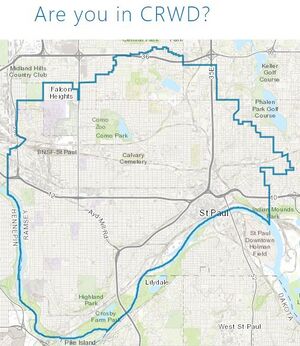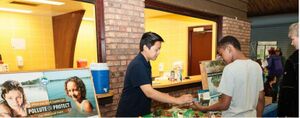
Environmental Justice Case Study: Capitol Region Watershed District (CRWD) Diversity Strategic Plan
A modern challenge faced by organizations of all sizes and scales is to ensure the programs and services they provide are accessible to all people. The Minnesota Pollution Control Agency (MPCA) defines environmental justice as policies which strive for the fair treatment and meaningful involvement of all people regardless of race, color, national origin, or income with respect to the development, implementation, and enforcement of environmental laws, regulations, and policies. Within this context, fair treatment means that no group of people should bear a disproportionate share of the negative environmental consequences resulting from industrial, governmental, and commercial operations or policies.
Capitol Region Watershed District (CRWD) is 40 square miles and spans portions of the Cities of Falcon Heights, Lauderdale, Maplewood, Roseville and Saint Paul. CRWD serves a highly diverse population of residents, and population trends show that the district is becoming more racially and ethnically diverse over time. Between 2000 and 2015, the percentage of people of color in the City of Saint Paul, which comprises 85% of CRWD, increased from 36% to 46%. Across Ramsey County, this percentage increased from 13% in 2000 to 30% in 2014. These trends are expected to continue through 2040.
In 2010, CRWD Board and staff created a diversity and inclusion statement acknowledging the need for a more thoughtful and strategic approach to CRWD’s diversity and inclusion work in an effort to better engage all of CRWD’s residents. In 2018, with the help of a Minnesota GreenCorps Member (link to MPCA's GreenCorps website), CRWD analyzed hundreds of grant-funded projects and found significantly less program participation in the central and eastern portions of CRWD including the Trout Brook, Saint Anthony Hill and Phalen Creek subwatersheds. These subwatersheds correspond to areas of racially concentrated poverty (ACP50) defined by Metropolitan Council as 40% or more of the residents live with incomes below 185% of the federal poverty threshold and 50% or more of the residents are people of color.
To proactively address environmental justice issues within the watershed district, CRWD established a Diversity Committee in 2016 and developed the following goals in preparation for creating its first Diversity Strategic Plan:
- CRWD and its service providers should reflect the racial, gender and cultural demographics of the watershed.
- Understand and incorporate cultural perspectives on water and government.
- Create opportunities for people of color in the environmental/water resources profession through training and recruitment.
- Consider equity and equality as a means to achieve diversity.
- Use water management as a tool to help address local and community concerns.
With assistance from Azon Consulting, internal interviews were conducted to outline CRWD’s cultural competency, mission, vision and values, and in 2018 CRWD’s first Diversity Strategic Plan was developed and approved. The Diversity Strategic Plan outlines internal (e.g., CRWD staffing, bias training, etc.) and external (grant programs, relationship building, etc.) strategies for promoting equity and environmental justice within the watershed district. Key efforts conducted since establishment of the Diversity Strategic Plan are summarized below:
- Best practices in hiring: reviewed and expanded posting of position descriptions and announcements, attendance at implicit bias training, and revised interview protocols and questions.
- Water resource professional services consultant pool expansion: expanded the distribution list of the 2019/2020 Request for Qualifications (RFQ) for general water resource professional services to include approximately 95 Minnesota businesses that meet WBE (women-owned) or MBE (minority-owned) certifications through MNUCP (Federal/State database) and/or CERT (Metro database administered by Saint Paul).
- Stewardship grant equity initiative: review of potential barriers to participation in the grant program by underserved communities. CRWD is offering higher grant awards and conducting promotion efforts in areas with low participation. Staff began reaching out to Saint Paul planning councils and other community groups in those areas to discuss the program and how residents, businesses and community groups can get involved as well as additional support provided by CRWD.
- Relationship building: began developing and/or deepening relationships with community groups serving areas of CRWD where engagement has been low, including presenting at community meetings and increased event attendance.
- CRWD diversity and inclusion staff group: CRWD staff has gathered over lunch to discuss a wide range of diversity, equity and inclusion topics to build a more inclusive team internally and to make connections to our work that reach outside the organization. These meetings have been focused on reading or watching memoirs, blogs, and videos as well as a role play activity depicting a local environmental justice case. The group has covered topics such as racism, gender equality, environmental justice, sexual identity/orientation, mental health, indigenous history, personality type.
- 2021 Watershed Management Plan: embedded Diversity Strategic Plan goals and implementation activities into updated 10-year watershed management plan to ensure it remains a focus of the CRWD’s future programs and projects. The plan also includes nine themes that reflect high level topics and CRWD values that will be considered and weaved into every aspect of CRWD’s work over the next 10 years.
Throughout implementation of the Diversity Strategic Plan, CRWD at times has run into barriers requiring flexibility and reevaluation of specific goals and outcomes. Making inroads into new communities takes time. CRWD has found that meeting audiences where they are by making intentional efforts to participate in community events (for example, participation in cultural events that are not explicitly connected to water management) is one meaningful strategy to introduce CRWD’s programs and projects to underserved communities. In addition, CRWD looks to communicate its programs and projects in ways that resonate with the intended audiences, including translating materials, amplifying the work of partners through storytelling and sharing, and incorporating the arts and technology into community engagement efforts.
CRWD has also learned that to succeed in being a diverse and equitable organization, it is important to hire staff and consultants that reflect the communities they serve. Staff has been working with partner groups to strengthen programming that educates and empowers young people of all backgrounds to pursue careers and higher education in natural resource fields.
An important lesson CRWD learned is that progress related to environmental justice issues does not always materialize in a linear way, and a key part of moving forward and advancing goals is embracing that journey, making progress without knowing what to expect and appreciating that some strategies may fail. The key is to learn from them and to make improvements.
More information regarding CRWD and their Diversity Strategic Plan can be found by visiting the CRWD website (https://www.capitolregionwd.org) or by contacting Mark Doneux, CRWD Administrator (mdoneux@capitolregionwd.org).
Project Location: Capitol Region Watershed District (portions of Saint Paul, Roseville, Lauderdale, Falcon Heights and Maplewood).
Completion Date: 2016 to Present (Ongoing)
Organizations Involved: CRWD staff, CRWD Board of Managers, CRWD Diversity Committee, CRWD Citizen Advisory Committee (CAC), Azon Consulting, Minnesota GreenCorps, and Ramsey County.
Project Budget Summary:
- External Consultants and Training: $25,000
- Staff and Board Costs: $10,000
Quantitative Outcomes:
- Best Practices in Hiring:
- All interview committee members completed an implicit bias training.
- New publications where positions were posted: African News Journal, Hmong Times, Insight News, LaPrensa/Vida y Sabor, MN Spokesman Recorder.
- CRWD received 284 applications for five positions. Demographics were not collected during the application process.
- Stewardship Grant Equity Initiative
- Staff conducted outreach to three Saint Paul District Planning Councils.
- Water Resource Professional Services Consultant Pool Expansion
- 95 Minnesota businesses that meet WBE (women-owned) or MBE (minority-owned) certifications through MNUCP received the 2019-2020 Request for Qualifications
- CRWD received six new Statements of Qualifications from disadvantaged business enterprises (DBE) bringing the total DBE firms in the pool to seven.
- 8 Best Management Practice maintenance service providers (landscape contractors) including 4 DBEs received the request for quotes for 2020 services.
- CRWD hired a DBE firm to provide 2020 BMP maintenance services.
- Relationship Building
- In 2019, CRWD made connections with nearly 11,000 residents at over 70 different events. Events included school presentations, tours, community gatherings and others reaching audiences of all backgrounds and ages across the watershed. CRWD emphasized its presence in neighborhoods and with cultural and ethnic groups CRWD had previously not worked with.
- CRWD Diversity and Inclusion Staff Group
- 12 meetings to explore a variety of diversity and inclusion topics.
</noinlude>
This page was last edited on 8 December 2022, at 14:55.



